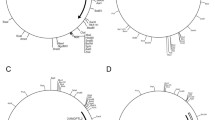Abstract
The peptide signal sequence for protein O-glycosylation is not fully characterized, although a recent in vitro study proposed that the sequence motif, XTPXP, serves as a signal for mucin-type O-glycosylation. Here, we show that the AATPAP sequence acts as an efficient O-glycosylation signal, in vivo. A secreted fibroblast growth factor (secFGF) was used as a model to analyze glycosylation and its effects on the biological activity of FGF. Two constructs encoding [AATPAP]secFGF in which AATPAP was introduced at the N- or C-terminus of secFGF were constructed in a eukaryotic expression vector. [AATPAP]secFGF proteins were then expressed in Chinese hamster ovary (CHO) cells and secreted into the surrounding medium, primarily as modified forms sensitive to sialidase but not to peptide N-glycosidase F. The modifying groups were not seen when the AATPAP sequence was converted to AAAPAP or when [AATPAP]secFGF was expressed in mutant cells incapable of UDP-GalNAc biosynthesis. The results indicate that the modifying groups were mucin-type O-glycans and that the AATPAP served as an efficient O-glycosylation signal sequence. The O-glycosylated forms of [AATPAP]secFGF were as mitogenic toward human vascular endothelial cells as unmodified secFGF, suggesting that introduction of the signal into biologically active polypeptides is a promising approach with which O-glycosylation may be achieved without affecting original activity.
Similar content being viewed by others
References
Kaplan HA, Welply JK, Lennarz WJ (1987) Biochim Biophys Acta 906: 161–73.
Kornfeld R, Kornfeld S (1985) Annu Rev Biochem 54: 631–64.
Elhammer AP, Poorman RA, Brown E, Maggiora LL, Hoogerheide JG, Kezdy FJ (1993) J Biol Chem 268: 10029–38.
Yoshida A, Suzuki M, Ikenaga H, Takeuchi M(1997) J Biol Chem 272: 16884–88.
McKeehan WL, Wang F, Kan M(1998) Prog Nucleic Acid ResMol Biol 59: 135–76.
Imamura T, Mitsui Y (1987) Exp Cell Res 172: 92–100.
Imamura T, Engleka K, Zhan X, Tokita Y, Forough R, Roeder D, Jackson A, Maier JA, Hla T, Maciag T (1990) Science 249: 1567–70.
Aiyar A, Xiang Y, Leis J (1996) Methods Mol Biol 57: 177–91.
Mikaelian I, Sergeant A (1992) Nucleic Acids Res 20: 376.
Mikaelian I, Sergeant A (1996) Methods Mol Biol 57: 193–202.
Asada M, Yoneda A, Oda Y, Ota K, Ozawa K, Fukuta K, Omae F, Asanagi M, Orikawa N, Suzuki M, Oka S, Makino T, Imamura T (1999) Growth Factors 16:293–303.
Imamura T, Oka S, Tanahashi T, Okita Y (1994) Exp Cell Res 215: 363–72.
Zhu X, Komiya H, Chirino A, Faham S, Fox GM, Arakawa T, Hsu BT, Rees DC (1991) Science 251: 90–93.
Pineda-Lucena A, Jimenez MA, Lozano RM, Nieto JL, Santoro J, Rico M, Gimenez-Gallego G (1996) J Mol Biol 264: 162–78.
Krieger M, Brown MS, Goldstein JL (1981) J Mol Biol 150: 167–84.
Krieger M, Reddy P, Kozarsky K, Kingsley D, Hobbie L, Penman M (1989) Methods Cell Biol 32: 57–84.
Yoshida A, Hara T, Ikenaga H, Takeuchi M(1995) Glycoconjugate J 12: 824–28.
Hansen JE, Lund O, Engelbrecht J, Bohr H, Nielsen JO, Hansen J-ES, Brunak S (1995) Biochem J 308: 801–13.
Hansen JE, Lund O, Rapacki K, Brunak S (1997) Nucleic Acids Res 25: 278–82.
Hansen JE, Lund O, Tolstrup N, Gooley AA, Williams KL, Brunak S (1998) Glycoconjugate J 15: 115–30.
Yoneda A, Asada M, Suzuki M, Imamura T (1999) BioTechniques (in press).
Author information
Authors and Affiliations
Corresponding author
Rights and permissions
About this article
Cite this article
Asada, M., Orikasa, N., Yoneda, A. et al. The AATPAP sequence is a very efficient signal for O-glycosylation in CHO cells. Glycoconj J 16, 321–326 (1999). https://doi.org/10.1023/A:1007092708666
Issue Date:
DOI: https://doi.org/10.1023/A:1007092708666




